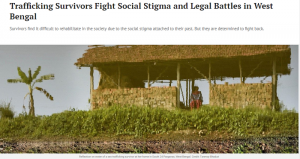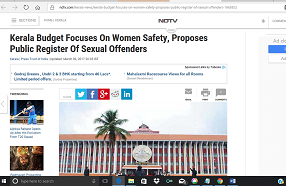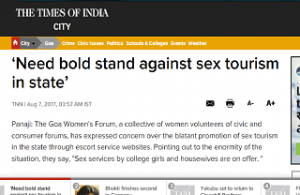Trafficking Survivors Fight Social Stigma & Legal Battles in West Bengal

Date: Tuesday, August 21, 2018
Location: Kolkata, West Bengal, India
A jump from the second position to the first should normally be a thing to celebrate, but not in the case of West Bengal, which recorded the most cases of human trafficking in 2016. According to data published by the National Crime Records Bureau (NCRB), the state reported 3,579 human trafficking cases that year. The number might be a gross underestimate, as the NCRB data show that 53,654 women and 16,881 children were missing from the state during the same period.
A study conducted by International Justice Mission (IJM) and the West Bengal Commission for Protection of Child Rights (WBCPCR) in Kolkata, Howrah, North and South 24 Parganas and East Medinipore districts showed that a total of 4,143 sex workers were documented from 451 public establishments (shelter homes for rescued persons run by governments and NGOs) and 131 sex workers from 40 private establishments (brothels, small hotels). According to the study, the prevalence of minors in public establishments is 0.8% while it is 18 % in the case of private establishments. The minors observed in private establishments were 15 to 17-year-olds, and all of them were from West Bengal.
Over the past few years, West Bengal has seen the return of several rescued girls. Mostly in their twenties, these girls have escaped a nightmarish past but they are facing several hurdles as they try to resettle in their societies. Not only do they have to come to terms with the psychological trauma of being forced into sex trade, but they also have to continuously battle the social stigma that comes attached to their past. But the story of Nasima, Shefali and Pavi is one of resilience and determination as they are fighting social taboos as they rebuild their lives.
Legal battle for justice
Nasima* was in love with a boy, who promised to marry her. But the shock of her life came when the boy sold her off to a sex trafficker in Delhi in mid-2016. The trafficker raped her repeatedly and sold her off to someone else. She was sold again and again, and was transported across North Indian towns as a sex slave. “I never understood that this could happen to me. I loved him and that became the trap,” said Nasima, who is now 19 years old.
The continuous physical torture deteriorated her health, because of which she had to be admitted to a hospital. She was diagnosed with AIDS. The administering doctor, upon realising that Nasima was a sex slave, informed the local police immediately. Following swift action by the police and other organisations such as International Justice Mission and their partner NGOs, Nasima was rescued and brought to her home in South 24 Parganas. The culprit was eventually arrested. Nasima’s case is in the district court, to which she makes regular visits.
“My return from Delhi led to a social boycott of our family. Even buying daily grocery became a challenge. Everyone was curious about my past. I didn’t step out from home for months. My mother still does not want me to go out alone,” Nasima said. After her rescue, she traveled regularly to Kolkata to arrange the documents needed to apply for compensation as a victim. She has now got her compensation on the basis of a 2010 directive by the Supreme Court that victims of sexual assault, acid attacks and trafficking be paid compensation. According to the West Bengal Victim Compensation Scheme, victims of human trafficking are paid a compensation of Rs 1 lakh.
A house for Shefali
Uneducated and a victim of child marriage, Shefali, 22, grew up in extreme poverty. At 12, she was already separated from an abusive husband. Soon Shefali met a woman who promised her a job in Kolkata. The dream of a stable future in a big city came to her as a ray of hope for a new life.
But she was trafficked to Sonagachi and forced into child prostitution. When she was ultimately rescued, she testified boldly against her abusers. She now has a son. She was recently awarded by the government for persisting through her legal battles to receive compensation. “I have a dream of building my own house where I can happily live with my son. I have to win the battle for my son,” she said.
When Shefali returned to her village seven years later, she was alarmed to see her trafficking agent roaming freely in the village. Even during the legal battle, the advocate of the accused threatened her to withdraw the case.
Like Nasima, Shefali also faced social boycott after returning to her village home. “My family tries to maintain contact but I do not want to go back to my village. The society doesn’t want us to live peacefully. They still label us as bad girls and judge our characters.” Shefali now lives in a girls’ hostel in Kolkata and works at a sewing workshop.
Hockey gives her hope
Separated from her parents at a tender age, Pavi worked as a domestic servant, washing dishes and clothes without a salary. She was meanwhile physically abused by her master and being groomed for prostitution. The Kolkata Police rescued her when she was just eight years old. “I don’t know where my family is and if they still miss me. I have no idea about my parents, I am happy here in the shelter home with friends,” said Pavi, 16, who now lives in a government-aided shelter home for girls.
Pavi is now breaking the barriers of social stigma. She is now a district-level hockey player and wants to become a professional player. A class ten student, Pavi believes hockey is her path to success.
Nasima, Pavi and Shefali all said they are not afraid of any taboo and what the society thinks of them. They are confident and have found their way of life but they agree on one thing that this crime must be stopped and justice served.
Justice half served is justice denied
Low conviction rate seems to have led the culprits of sex trafficking to believe that they can commit more crimes without serious repercussion. A volunteer of the Birangana Mahila Samity – a non-governmental organisation based in Canning – who did not want to be named, said the same trafficking agent traps three to five girls in same way. The traffickers in rural Bengal range across genders – males, females and transgender persons. A joint study by the IJM and the WBCPCR has found that 80% of contacts (pimps, madams, traffickers) in private establishments were females. This debunks the notion that it is primarily men who are exploiters and pimps. The ages of these contacts ranged from 16 to 58 years.
According to data provided by the Ministry of Home, out of the 3,579 cases reported from West Bengal, chargesheets had been filed in 1,186 cases. This means that in one-third of the cases, the girls had been rescued and the perpetrators arrested. Many grassroots level organisations have started awareness campaigns among girls in schools along with the state government, but the problem lies in inadequate legal action against culprits.
“In most cases, police registered the case under sections 363, 366 and 366A of the Indian penal code for abduction and procurement of an underage girl. But they did not attach key sections of the Immoral Trafficking Prevention Act (ITPA) and the Protection of Children from Sexual Offences Act (POCSO),” said Amina Laskar, a social worker based in Canning.
Another reason for the low rate of convictions in cases of human trafficking in West Bengal is the lack of coordination between the police from the area from where the victims were picked up and the area where they were sold. Besides such lack of coordination, police are also reluctant to travel to different states to investigate the cases due to lack of resources. In some cases, police are accused of asking money from the victim’s family to travel to different states for investigation.
In several cases, the accused threatens the victim to withdraw the case or face dire consequences. Scared for their lives, the victim’s family members at times ask for the help of panchayat pradhan or leaders of the ruling political party. But, families of victims say, the pradhans and the leaders are often ‘well-managed’ by the accused. “Progressive policies towards child and women empowerment continue to deter the crime in West Bengal. However, the evolving nature of the crime requires law enforcement agencies to be sophisticated with technology and armed with legal knowledge,” said Saji Philip, Director of Operation the International Justice Mission, Kolkata.
Subhasree Raptan, a social worker based in the Sunderbans area, said, “There is some confusion in understanding the difference between elopement and trafficking. We often come across cases where a girl’s family tries to project an elopement case as trafficking. So it is a really tough job for us to ascertain the truth.”
An investigating officer, who did not want to be named, said, “As trafficking is nowadays the most organised crime, we need more power and laws to curb them. An investigating officer in Delhi will file a case against the brothel manager but won’t check where the girl was brought from. In such cases, we need an inter-state agency to investigate.”
According to Ananya Chakraborty, chairperson of the West Bengal Commission for Protection of Child Rights (WBCPCR), “The highest number of trafficking cases does not mean trafficking has risen in recent years. Actually, people are more aware nowadays and they register cases. Bengal also has the highest number of rescue in terms of registered trafficking cases. If the girl is a minor, we are very much involved in the rescue process. Otherwise, the state has a special task force and the Criminal Investigation Department (CID) who look after these cases.” Chakraborty also added that the lengthy judicial process is really a big problem. “But we ensure that the survivor gets her justice as early as possible,” Chakraborty added.
The districts that have the highest number of human trafficking include South and North 24 Parganas, Jalpaiguri, Alipurduar and Murshidabad. Two subdivisions in South 24 Parganas, Canning and Diamond Harbour have emerged as hubs of human trafficking. Under these circumstances, the district administration in South 24 Parganas launched a rehabilitation model – swayamsiddha – to fight the growing menace of trafficking of girls from the villages. SubhasreeRaptan, a social worker who runs this campaign in the Sunderban area, said swayamsiddha is an awareness campaign “involving teachers, students, panchayat members and parents whereby every stakeholder is informed about the modus operandi of the trafficking agents, the evils of trafficking, firsthand accounts of the survivors and safety tips for using social media.
Previously, every school and panchayat was equipped with a swayamsiddha box, which allowed girls to submit their suggestions. They could provide clues to the administration about suspicious movements of people their neighbourhood. Identity of the person providing such information would be protected. But the girls these days are so interactive that they are coming out to tell their issues without any hesitation.”
The model has already helped in preventing child marriage in some villages in the Sunderbans area. “We have reached more than 400 schools in the past one year. There are 200 survivors who are actively participating in our awareness campaign,” Subhasree added.
Nowadays, Nasima participates in the state government’s swayamsiddha program and spreads awareness among school-going girls in rural Bengal. “Don’t reply to phone calls or texts from unknown numbers and check twice before you get into a relationship with a boy. That person can ruin your whole life.” This is her message to all girls of her age. WBCPCR chairperson Ananya Chakraborty said there is much more to be done with this project, and that the success of this initiative depends on the panchayat, the survivor’s family and the society.
Legal framework
On July 26, the Trafficking of Persons (Prevention, Protection and Rehabilitation) Bill, 2018 was passed in the Lok Sabha amid concerns by the opposition. For Nasima, Pavi, Shefali and others like them, the Bill, yet to be passed by the Rajya Sabha, offers a ray of hope. Elaborating on the positive aspects of the newly passed Bill, PritiMahara, director of Policy, Research and Advocacy at Child Rights and You (CRY) said, “The Trafficking of Persons (Prevention, Protection and Rehabilitation) Bill of 2018 is indeed a welcome step as it addresses one of the most persistent yet invisible crimes affecting the most vulnerable persons, especially children and women. However, what is worrying is the silence on different forms of child trafficking such as trafficking for and through adoption, or trafficking of children by placement agencies for domestic servitude, which find no mention in the Bill.”
According to Priti Mahara, “The current Bill covers three aspects: prevention, protection and rehabilitation, which make it different and absolute (better than before). But it creates confusion as there is no mention in the current Bill replacing or superseding the Immoral Traffic (Prevention) Act (ITPA). Why do we need ITPA after this Act? Unless answered, it will lead to investigating and justice delivery mechanisms laid down under the ITPA to work parallel to those provided in this Bill. This will only increase the re-victimization of children and lack of accountability amongst authorities.” Mahara further said, “A very admirable part of the Bill, though, is setting up of institutional mechanisms at the district, state and national levels. Under the new Bill, the National Anti-Trafficking Bureau has been mentioned to co-ordinate and monitor surveillance and preventive efforts and also to form a National Anti-Trafficking Relief and Rehabilitation Committee.”
(Read The Wire (source) article here.
“It’s Saturday evening at the National Human Trafficking Hotline, and we’ve had non-stop calls since mid-afternoon. I know there are Read more
“It’s Saturday evening at the National Human Trafficking Hotline, and we’ve had non-stop calls since mid-afternoon. I know there are Read more



